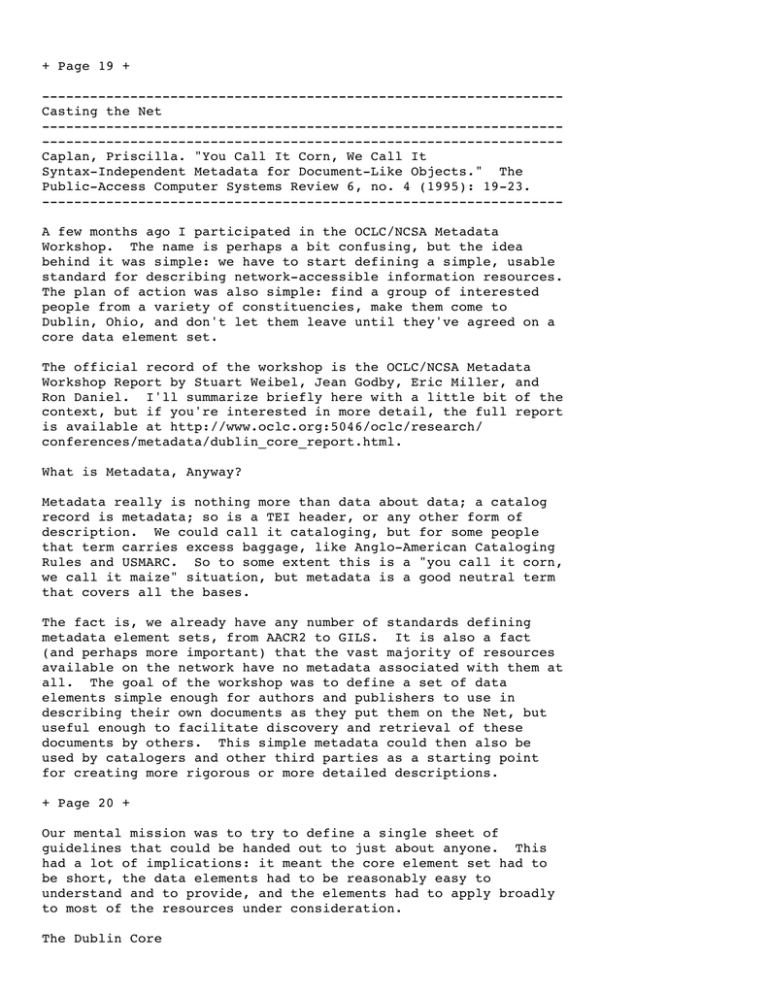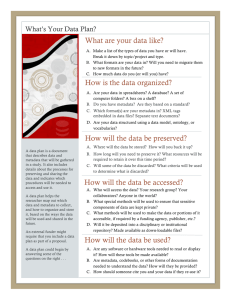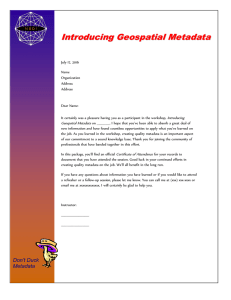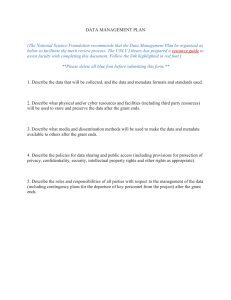
+ Page 19 +
----------------------------------------------------------------Casting the Net
--------------------------------------------------------------------------------------------------------------------------------Caplan, Priscilla. "You Call It Corn, We Call It
Syntax-Independent Metadata for Document-Like Objects." The
Public-Access Computer Systems Review 6, no. 4 (1995): 19-23.
----------------------------------------------------------------A few months ago I participated in the OCLC/NCSA Metadata
Workshop. The name is perhaps a bit confusing, but the idea
behind it was simple: we have to start defining a simple, usable
standard for describing network-accessible information resources.
The plan of action was also simple: find a group of interested
people from a variety of constituencies, make them come to
Dublin, Ohio, and don't let them leave until they've agreed on a
core data element set.
The official record of the workshop is the OCLC/NCSA Metadata
Workshop Report by Stuart Weibel, Jean Godby, Eric Miller, and
Ron Daniel. I'll summarize briefly here with a little bit of the
context, but if you're interested in more detail, the full report
is available at http://www.oclc.org:5046/oclc/research/
conferences/metadata/dublin_core_report.html.
What is Metadata, Anyway?
Metadata really is nothing more than data about data; a catalog
record is metadata; so is a TEI header, or any other form of
description. We could call it cataloging, but for some people
that term carries excess baggage, like Anglo-American Cataloging
Rules and USMARC. So to some extent this is a "you call it corn,
we call it maize" situation, but metadata is a good neutral term
that covers all the bases.
The fact is, we already have any number of standards defining
metadata element sets, from AACR2 to GILS. It is also a fact
(and perhaps more important) that the vast majority of resources
available on the network have no metadata associated with them at
all. The goal of the workshop was to define a set of data
elements simple enough for authors and publishers to use in
describing their own documents as they put them on the Net, but
useful enough to facilitate discovery and retrieval of these
documents by others. This simple metadata could then also be
used by catalogers and other third parties as a starting point
for creating more rigorous or more detailed descriptions.
+ Page 20 +
Our mental mission was to try to define a single sheet of
guidelines that could be handed out to just about anyone. This
had a lot of implications: it meant the core element set had to
be short, the data elements had to be reasonably easy to
understand and to provide, and the elements had to apply broadly
to most of the resources under consideration.
The Dublin Core
Deciding just what resources were under consideration was an
interesting issue. We finally limited ourselves to
"document-like objects" or "DLOs," but we didn't waste much time
defining what a DLO was, or what it wasn't. To me, an electronic
text, map, or image would clearly be a DLO. To some
participants, only textual materials qualified, while to others,
computer systems or even people could be DLOs. The important
thing was that the core data element set did not have to handle
every type of resource that could theoretically be available on
or through the network. It had only to handle things like, well
. . . document-like objects.
The core element set itself, sometimes referred to as the Dublin
Core, is still a moving target. The standard proposed in the
workshop report will change over time as more people work on it
and with it. As I write this, it consists of 13 elements. The
first five elements, author, title, subject, publisher and date
of publication, are for author, title, subject, and . . . you get
the idea. The remaining elements are summarized in the report as
follows:
OtherAgent: The person(s), such as editors and transcribers,
who have made other significant intellectual contributions
to the work.
Identifier: String or number used to uniquely identify the
object.
ObjectType: The genre of the object, such as novel, poem, or
dictionary.
Form: The data representation of the object, such as
PostScript file or Windows executable file.
Relation: Relationship to other objects.
Language: Language of the intellectual content.
+ Page 21 +
Source: Objects, either print or electronic, from which this
object is derived, if applicable.
Coverage: The spatial locations and temporal durations
characteristic of the object.
Every data element is optional and repeatable. Each element can
also have subelements to qualify or explain the content of the
element. For example, the subelement called "scheme" can be used
to identify the authority or rule set used to provide the data
element. Subject could have a subelement called "scheme=LCSH" to
identify an LC subject heading, or "scheme=abstract" if an
abstract were provided instead of subject headings.
You may be wondering how it could have taken 50 people three days
to come up with a list of core elements. But the issues are
fairly complex. Consider the concept of Author, for example.
Earlier drafts had a single element (ResponsibleAgent) for all
parties contributing to the intellectual content of the work,
very much like a 7xx added entry field in USMARC. The type of
agent, like author or illustrator, would be identified in a
subelement called "role." But some people argued that the
concept of Author is so intuitive it needed to be singled out.
If that's the case, what must be known about Author? In USMARC
you need to indicate whether the author is a person, conference,
or company; determine if the author should be a main or added
entry; and decide what type or form of name it is. For the core
element Author, you might be able to make these distinctions with
qualifying subelements, but we weren't willing to be more
restrictive than to require that names be in inverted order or
sort order. The real wonder isn't what took us so long, but that
we came up with anything at all.
One of the most important things to note about the proposed
metadata standard is that it doesn't prescribe how to record this
information; it is "syntax independent." The data may be
represented in USMARC, HTML, SGML, or "keyword=value" pairs.
Whatever you can process and exchange with your community is
fine. This is a data element set, not a transport syntax. If
you want to add data elements to the list, that's fine too. If
you're part of a special community working with a special type of
object, you can even define domain-dependent extensions, just as
long as you don't expect everyone else to understand them.
+ Page 22 +
Under Construction: Hardhat Required
What gives us hope that the Dublin Core will ever be adopted? I
think it's partly a function of need and partly a function of the
people who participated in the workshop. At times, the meeting
reminded me of the bar scene in "Deep Space Nine": dozens of
alien species milling about and talking slightly different
English-like languages. There were the librarians, mostly
middle-aged women like me, enduring endless jokes about sensible
shoes. There were the IETF guys, astonishingly young and looking
as if they were missing a fraternity party to be there. There
were TEI people, GILS people, and geospacial metadata people.
There were publishers and software developers and researchers.
Every participant had his or her own perspective, and a few
people had axes to grind, but nearly everyone agreed that there
was a tremendous need for some standard and that an imperfect
standard would be better than no standard at all.
Of course, there is a danger here: it's easy for anything to seem
better than nothing until you have it. Non-librarians working on
the metadata standard need to acknowledge that there are reasons
why cataloging isn't simple or easy and that, with every
simplification you make, you lose something in consistency or
capability. Librarians need to see this initiative as a
complementary, not a competitive, effort that needs our
participation to succeed. This is an area full of tradeoffs, and
I don't believe we've yet found the appropriate balance between
effort and utility. We will, though, if we keep working at it.
Now that the workshop is behind us, the real work begins. A
small group of participants have drafted the workshop report and
will continue to refine the data element set. Those of us
involved with particular data formats like USMARC or SGML must
work in our respective communities to see how these metadata
elements can be represented in our own syntaxes. Librarians have
already begun their efforts with two discussion papers on the
Dublin Core presented at MARBI during ALA in Chicago this summer:
"DP86, Mapping the Dublin Core Metadata Elements to USMARC" and
"DP88, Defining a Generic Author Field in USMARC." Like the
librarians, workshop participants involved in standards like the
URC (Universal Resource Characteristics) need to investigate how
the metadata standard fits into their existing standards. Those
who are writing software need to see how they can incorporate
metadata into their software.
Meanwhile, I'm going to sit back and meta-tate on how nice it
will be someday to actually be able to find some of those
document-like objects out there when I want them.
+ Page 23 +
Appendix A: Metadata for This Article
Author = Caplan, Priscilla
Title = You Call It Corn, We Call It Syntax-Independent Metadata
for Document-Like Objects
Publisher = The Public-Access Computer Systems Review
ObjectType = Article
Subject = Metadata
Subject = OCLC/NCSA Metadata Workshop
Subject = Cataloging Internet Resources
Date = 1995
About the Author
Priscilla Caplan, Assistant Director for Library Systems,
University of Chicago Library, 1100 E. 57th Street Chicago, IL
60637. Internet: p-caplan@uchicago.edu.
About the Journal
The World-Wide Web home page for The Public-Access Computer
Systems Review provides detailed information about the journal
and access to all article files:
http://info.lib.uh.edu/pacsrev.html
Copyright
This article is Copyright (C) 1995 by Priscilla Caplan.
Rights Reserved.
All
The Public-Access Computer Systems Review is Copyright (C) 1995
by the University Libraries, University of Houston. All Rights
Reserved.
Copying is permitted for noncommercial, educational use by
academic computer centers, individual scholars, and libraries.
This message must appear on all copied material. All commercial
use requires permission.



